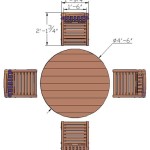How Much to Remove a Concrete Patio: Factors Influencing the Cost
Removing a concrete patio can be a necessary home improvement project for various reasons, including replacing it with a new patio, installing landscaping, or addressing structural issues. Understanding the factors that influence the cost of concrete patio removal is crucial for budgeting and ensuring a smooth project execution. The final cost can vary significantly based on several variables, making it essential to obtain detailed estimates from qualified contractors.
The price of removing a concrete patio is not a fixed amount. It is contingent on a combination of elements ranging from the patio's dimensions and thickness to the accessibility of the site and the prevailing labor rates in the geographic area. Furthermore, associated costs such as disposal fees and any required permits can contribute to the overall expenditure. Failing to consider these elements can lead to budgetary miscalculations and unwelcome financial surprises during the project.
This article provides a comprehensive overview of the key factors affecting the cost of concrete patio removal. It aims to equip homeowners with the knowledge necessary to make informed decisions and navigate the removal process effectively. Understanding these cost drivers will empower individuals to obtain accurate estimates, compare quotes intelligently, and plan their projects accordingly.
Patio Size and Thickness
The size of the concrete patio is a primary determinant of the removal cost. Larger patios require more labor, equipment, and time to demolish and haul away. Contractors typically estimate removal costs on a per-square-foot basis. This allows for a scalable pricing model based on the patio's surface area. A significantly larger patio will invariably translate into a higher overall removal expense.
In addition to the surface area, the thickness of the concrete also plays a crucial role. Thicker concrete requires more powerful equipment and a greater amount of effort to break up and remove. Standard residential patios are typically four inches thick. However, some patios, particularly those designed for heavier use or in regions with harsh climates, may be thicker, sometimes reaching six inches or more. The added thickness dramatically increases the time and resources needed for demolition, consequently increasing the removal cost.
Contractors must use specialized tools like jackhammers, concrete saws, and heavy machinery to break up thicker concrete slabs. The increased wear and tear on equipment, combined with the extended labor time, contributes to the overall price. When obtaining estimates, it is important to specify the dimensions and thickness of the patio accurately to ensure that the contractor can provide an appropriate and precise quote.
Accessibility and Site Conditions
The ease of access to the patio significantly influences the cost of removal. Patios located in easily accessible areas, such as those directly adjacent to a driveway, will be less expensive to remove than those in difficult-to-reach locations. Limited access necessitates the use of smaller equipment, hand tools, and potentially longer labor hours, resulting in higher costs.
For instance, if a patio is located in a backyard with a narrow gate or requires navigating through landscaping, contractors may need to use wheelbarrows or other manual methods to transport debris. This increases the time and effort involved, leading to higher labor costs. Similarly, patios located on steep slopes or with uneven terrain can pose additional challenges, requiring specialized equipment or techniques and further contributing to the overall expense.
Site conditions, such as the presence of buried utilities or underground structures, can also impact the removal cost. Contractors must exercise caution to avoid damaging any underground infrastructure. This may require additional precautions, such as hand digging or using specialized equipment. The presence of obstacles like trees or shrubs near the patio can also complicate the removal process and increase costs. Homeowners should inform contractors about any potential site-specific challenges to ensure accurate cost estimates and avoid unexpected expenses during the project.
Disposal Fees and Local Regulations
Disposal fees represent a significant portion of the overall concrete patio removal cost. Concrete debris is heavy and requires specialized disposal methods. Landfill fees for concrete disposal vary by location and are usually charged per ton. The further the distance to the disposal site, the higher the transportation costs will be, driving up the overall expense.
Some municipalities may have specific regulations regarding concrete disposal. These regulations may require recycling concrete rather than sending it to a landfill. Recycling concrete can sometimes be more expensive than landfill disposal, depending on the availability of recycling facilities and the associated processing fees. Homeowners should inquire about local regulations regarding concrete disposal to understand the potential costs involved.
In addition to disposal fees, obtaining the necessary permits can contribute to the overall cost. Some areas require permits for demolition or removal of concrete structures. The cost of permits varies by municipality and depends on the scope of the project. Failing to obtain the required permits can result in fines and delays. Contractors are typically responsible for obtaining the necessary permits, but homeowners should verify that this is included in the scope of work and cost estimate.
Equipment and Labor Costs
The type of equipment required for removing a concrete patio depends on the size, thickness, and location of the patio. Smaller patios may be removed using hand tools and smaller jackhammers. Larger or thicker patios may require heavier equipment such as skid steers, excavators, and concrete saws. The cost of renting or owning this equipment is factored into the overall project cost.
Labor costs are another significant contributor to the removal expense. Labor rates vary by geographic location and the experience level of the workers. The more complex the removal project, the more skilled labor will be required, increasing the labor costs. Factors such as the need for manual labor due to limited access, the presence of obstacles, and the need for specialized techniques can all lead to an increase in labor costs.
Contractors typically charge an hourly rate or a flat fee for labor. Hourly rates are often used for smaller projects or those with unpredictable timelines. Flat fees are more common for larger projects with clearly defined scopes of work. When obtaining estimates, it is essential to understand how the contractor calculates labor costs and what is included in the labor rate. Understanding these components will help you compare quotes and ensure that you are receiving a fair price for the work being performed.
Additional Services and Potential Hidden Costs
Beyond the basic removal of the concrete patio, additional services may be required, which can further impact the overall cost. These might include site preparation, which could involve grading the area after removal, leveling the ground, or adding topsoil. If the homeowner intends to install a new patio or landscaping in the same location, these preparatory steps become essential.
Another potential additional service is the removal of any underlying structures or material. For instance, if the concrete patio sits on a gravel base or a layer of compacted soil, the homeowner might wish to have this removed as well. The removal of this extra material will add to the disposal costs and require additional labor.
Hidden costs can also arise during the removal process. Unexpected issues such as discovering asbestos or other hazardous materials within the concrete or beneath it can lead to significant cost overruns. If underground utilities are not properly marked and are accidentally damaged, the repair costs can be substantial. It is recommended to have a contingency fund to cover potential unexpected issues that may arise during the removal process.
Geographic Location
The geographic location of the property is a significant factor that influences the cost of concrete patio removal. Labor rates, disposal fees, and permitting costs vary significantly from region to region. Areas with higher costs of living tend to have higher labor rates, which translates to higher removal costs. Similarly, disposal fees can be higher in areas with limited landfill space or stricter environmental regulations.
Seasonal variations can also affect the cost of concrete patio removal. In regions with harsh winters, the ground may be frozen, making demolition and removal more difficult and time-consuming. This can drive up labor costs and potentially require specialized equipment. Demand for construction services can also fluctuate seasonally, leading to price variations. Contractors may charge higher rates during peak seasons when demand is high.
Local regulations and permitting requirements can also vary by location. Some municipalities may have stricter regulations regarding demolition and disposal, which can add to the overall cost. It is important to research local regulations and obtain the necessary permits before starting the project to avoid fines and delays. Obtaining estimates from local contractors who are familiar with local regulations and cost structures will ensure a more accurate and comprehensive cost assessment for the concrete patio removal project.
Concrete Recycling Options
The decision to recycle concrete, as opposed to sending it to a landfill, can influence the overall cost of the project. While recycling is environmentally responsible, the economic implications depend largely on the availability of local recycling facilities and the related processing fees. In some areas, recycling concrete may be more economical due to lower tipping fees or incentives for using recycled materials.
The process of recycling concrete involves crushing the concrete into aggregate, which can then be used as a base material for new construction projects, road construction, or other applications. This reduces the demand for virgin aggregates and conserves natural resources. However, the transportation of concrete to a recycling facility can add to the overall cost, especially if the facility is located far from the project site.
When obtaining estimates, homeowners should inquire about the contractor’s recycling practices and the associated costs. Some contractors may have relationships with local recycling facilities and can offer competitive pricing for concrete recycling. It is also worth investigating whether local rebates or incentives are available for using recycled materials in construction projects. Choosing to recycle concrete not only benefits the environment but can also potentially reduce the overall cost of the project.
DIY vs. Professional Removal
Homeowners may consider tackling the concrete patio removal as a do-it-yourself project to save money. While DIY removal can be cost-effective, it requires a significant investment of time, effort, and specialized equipment. It also carries the risk of injury and potential damage to property or underground utilities.
DIY removal typically involves renting or purchasing tools such as jackhammers, concrete saws, and sledgehammers. The cost of renting or purchasing these tools can quickly add up. Additionally, homeowners must have the physical strength and stamina to operate these tools safely and effectively. Improper use of equipment can lead to injuries and costly repairs.
Professional concrete removal contractors have the experience, equipment, and insurance to handle the project safely and efficiently. They are also familiar with local regulations and disposal requirements. While hiring a professional contractor will cost more upfront, it can prevent costly mistakes and ensure that the project is completed safely and to code. For larger or more complex projects, hiring a professional is almost always advisable.

How Much Does Concrete Removal Cost

How Much Does Concrete Removal Cost In 2024 Checkatrade

How To Break Up Concrete Budget Dumpster

Guide How Much Does Concrete Removal Cost

Average Concrete Removal Cost By Square Foot And More Forbes Home

What You Should Know About Removing A Concrete Patio Attached To House Hometown Demolition

How Much Does It Cost To Remove A Patio

How To Remove Your Concrete Patio Dumpsters Com

Removing A Concrete Patio By Hand Delineate Your Dwelling

Remove Concrete Slabs Deck Bros
Related Posts








